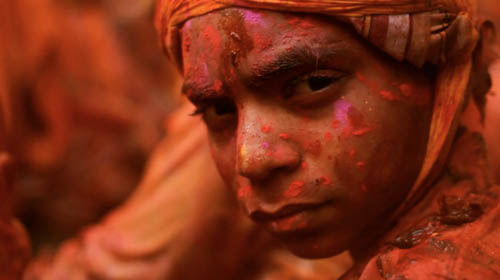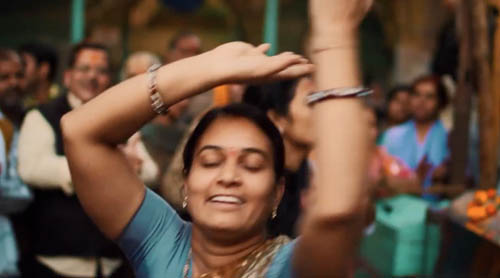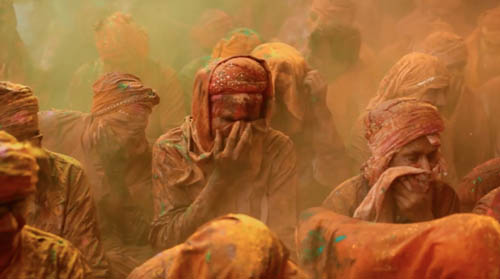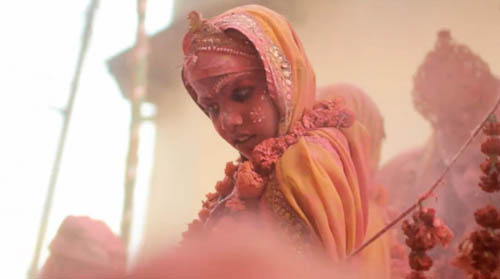|
|
|
Film by Prashant Bhargava Ron Fricke's 1992 classic Baraka endures as one of the most consummate examples of non-narrative cinema. Its montage of images from around the world was even more eclectic than the soundtrack that went along with it. But despite the many ceremonies, creative arts, and labors that Fricke documented—including death pyres and ritual baths in the river Ganges—he never captured the Hindu religious festival known as Holi. Had he done so, it might have looked something like Radhe Radhe. Filmmaker Prashant Bhargava's ode to this so-called “festival of colors” traces the eight-day celebration back to Mathura, mythic birthplace of the supreme deity Krishna and his lover (in the strongest sense) Radha. Hence the film's title, a term of praise and greeting often exchanged in the streets of Mathura, where she is believed to be a gateway to true understanding of Krishna. Her power is a central theme, an explosion of devotion far more vivid than the human-made pigment sold on the streets in the weeks leading up to this cathartic event.
An excerpt from the production by Khushi Films Given the film's subtitle, “Rites of Holi,” and the fact that Holi is practiced in the spring may put one in mind of Igor Stravinsky. This is no coincidence. Although not a direct homage to Stravinsky, Radhe Radhe was the result of a commission for the 100th anniversary of the Russian composer's Rite of Spring, and one of a dozen projects freshly created in its honor. It is still a ballet of sorts, not least of all for the dialogic contributions of Indian-American pianist Vijay Iyer. In a manner of speaking, he and Bhargava met halfway—the director boiling down over 30 hours of footage into a 35-minute film and the composer expanding molecular impressions into a fully integrated score—so that the finished product was a narrative duly rendered. Iyer's task was to match Bhargava's rhythms, taking the listener through what he calls a “series of energies.”
 Bhargava first gained international attention with his debut feature Patang (The Kite) in 2011. That his roots grabbed their soil in hip-hop and graffiti art should come as no surprise, for his gifts of rhythm, poetry, and color were likeminded in their urban respect. But with Radhe Radhe he went further underground, mining deeper traditions of those same creative registers. The film is, then, as much a musical as it is a visual tour de force, building like a raga to near-ecstatic heights. Indeed, before a single image graces our retinas, Iyer's pianism sets the stage over a dark title screen. Slight dissonances therein betray something of the chaos about to unfold, but obscure enough of it so that we might experience it anew, even in multiple viewings. Along with the young musicians of the International Contemporary Ensemble, Iyer creates a mood that is beautifully unsettling, and all the more organic for it.
 The film's first part, “Adoration,” builds its intimacies one stratum at a time. The stage is set in a misty landscape. We see only details: boatmen preparing for the days' revelry, a bare back, a glimpse of braided hair. The streets then come to life as food vendors ready their meals and women wash their garments in the river. The soundtrack is restless, anticipatory. A cargo train passes by, as if to underscore the film's narrative drive. More fragments: a face half-reflected in a mirror, candles burning on an altar, a gossamer veil. As crowds thicken and the dance begins, Iyer's pianism brightens. Even the birds in the field seem to join in. Flute and brass contrast one another with purpose. Their notes flower and wither, changing focus like the lens that guides them. Strings and percussion add color streamers of their own as the iconic powder hits the air.
 Part 2, “Transcendence,” puts further emphasis on Bhargava's footage of an imaginary Radha played by actress Anna George. He spins from these scenes, shot in the US and woven throughout the film, a primal and sexual interplay that signals the true emergence of spring. It's a bold move, as the director himself is first to admit in the DVD's “Making Of” segment, but he wanted to bring that “everyday magic, that intimacy that we share as people to the narratives of the gods.” He believes that the push and pull of Radha and Krishna exists in all of us, as it does also in the increasingly inseparable relationship between sounds and scenarios. A trumpet, for example, works its melodic overlay during a long shot of Radha's face, implying an environment far vaster than the immediate contrivance of the studio. As the cinematography becomes more contemplative, the music subdues itself in solidarity. In the same way that Bhargava seems to have eyes in many places at once and flits between them by changing cognitive channels, so too does Iyer's complementary switching take every movement into account. A sensual flowering of street noise enters the mix, as if bleeding of its own volition, leaving us wanting to shed our inhibitions and dive into that sea of color.
 In May of 2015, Bhargava died at the age of 42 from cardiac arrest after a history of heart disease. But the tragedy of this death is so graciously balanced by the exuberance of his small yet vivid oeuvre that one can focus on the latter in a state of pure invigoration. In this respect, we do well to read Radhe Radhe in the spirit for which it was made. In a world where the rites of Holi have spread to unlikely corners (I witness its rainbowed aftereffects on my American university campus every year), it's nice to know that one artist's vision can bring us anytime to the source with just the press of a PLAY button. - Tyran Grillo
|
|
|
|